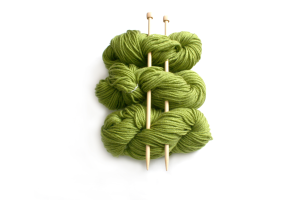Knitting is a delicate art, and anyone who’s spent time working with yarn knows how frustrating it can be to make a mistake—whether it’s dropping a stitch, getting the stitch count wrong, or realizing that a row was completely off. Fortunately, there’s a clever solution that experienced knitters swear by: lifeline yarn. If you’re wondering what lifeline yarn is, why it’s used, and how to use it effectively, this article has all the answers. We’ll also explore error solutions, techniques, and tips to make your knitting process smooth and mistake-free.
Knitting can be a therapeutic and creative process, but it’s not without its challenges. For both beginners and seasoned knitters alike, mistakes are an inevitable part of the journey. From miscounting stitches to accidentally skipping a row, these errors can lead to hours of undoing and frustration. That’s where lifeline yarn comes in as a game-changer. This simple yet highly effective tool helps you secure your work and gives you peace of mind when things go wrong. By threading a piece of yarn through the stitches of your work, lifeline yarn provides a safety net that allows you to rip back your project without losing everything you’ve already knitted.
Lifeline yarn is especially valuable when you’re tackling complex patterns or intricate lacework, where undoing a mistake can feel like an overwhelming task. Instead of painstakingly unraveling your knitting row by row, you can safely rip back to the point where the lifeline yarn is placed, saving you both time and effort. It’s an essential technique that many experienced knitters use regularly to ensure that their projects stay on track, even when things go wrong. In this article, we’ll walk you through the benefits of lifeline yarn, demonstrate how to use it properly, and share expert tips to help you get the most out of this clever solution. Whether you’re working on a simple scarf or an elaborate shawl, lifeline yarn can help take your knitting skills to the next level.
What is Lifeline Yarn in Knitting?
Lifeline yarn is a simple but brilliant tool in knitting, providing a safety net for your project. Think of it as a “backup” line that saves your work if you make a mistake. When inserted into your knitting at strategic points, it holds the stitches in place, ensuring that you can unravel your project safely without losing all your hard work. It’s like a personal safety rope while you climb the knitting mountain!
Why Knitters Use Lifeline Yarn
Knitters use lifeline yarn for one primary reason: to prevent major disasters. Whether you’re working on a delicate lace shawl or a complex sweater, mistakes can happen, and if you have a lifeline, fixing errors becomes much easier. It allows you to rip back your work to a specific point without the risk of losing stitches or messing up the entire project.
Understanding Lifeline Yarn
The Purpose of Lifeline Yarn
Lifeline yarn serves as a security line, enabling knitters to pull back to a point where the work was error-free. It’s inserted into the stitches of your knitting to “capture” them, making it possible to fix any mistakes without unraveling the entire piece. It’s especially useful in projects where the pattern is intricate, like lace or colorwork.
How Lifeline Yarn Works in Knitting
When you make a mistake in your knitting, you don’t have to unravel everything. By inserting lifeline yarn through the stitches on a row, you create a “line” to hold the stitches in place. If you need to undo the work, you can pull back to the lifeline, saving your stitches from unraveling completely.
Materials Used for Lifeline Yarn
The type of yarn used for lifelines doesn’t need to be fancy. In fact, many knitters use a contrasting color of cheap or scrap yarn. The goal is to have a smooth and durable string that won’t fray or get stuck in your project. Some prefer using nylon or cotton thread, as they’re sturdy and slide through stitches easily.
Choosing the Right Yarn for Lifelines
While the material of the lifeline yarn isn’t as important as the main yarn you’re using, you do want to select something that won’t snag. Avoid using very fluffy or textured yarns, as they could get tangled and complicate your error solution.
The Importance of Lifeline Yarn in Knitting Projects
Avoiding Common Knitting Errors
Lifeline yarn provides a way to undo mistakes without destroying your entire project. Common errors, such as dropped stitches or unintentional increases, are much easier to fix with a lifeline in place.
How Lifeline Yarn Helps Fix Mistakes
If you’ve made a mistake several rows down, lifeline yarn lets you unpick your knitting stitch by stitch and rip back to a safe point. This is particularly helpful in lace patterns, where a mistake in one row can unravel the entire piece.
Keeping Track of Your Stitch Count
One of the most common mistakes in knitting is losing track of your stitch count. Lifeline yarn can act as a marker, helping you keep track of your progress, especially when working on long or complex patterns.
How to Use Lifeline Yarn in Your Knitting
Inserting Lifeline Yarn
To use lifeline yarn, simply thread the yarn through the stitches of a completed row. Use a tapestry needle or a crochet hook to pass the lifeline yarn through each stitch. It’s important to do this carefully to avoid pulling too tightly on the yarn or skipping stitches.
The Best Times to Insert Lifeline Yarn
The ideal time to insert a lifeline is after a few rows or at a point where you’ve completed a pattern repeat. This ensures that you have a safe point to return to in case of errors.
How to Secure the Lifeline Yarn
Once the lifeline is threaded through the stitches, make sure to secure both ends of the yarn. You can tie a knot to keep it in place, but avoid pulling too tight, as it might distort the stitches.
Tips for Smooth Insertion
If you’re new to using lifeline yarn, it may feel a bit tricky at first. To make the process smoother, try using a thinner yarn for the lifeline to prevent it from getting tangled with your main yarn.
Error Solutions Using Lifeline Yarn
What to Do When You Make a Mistake
When you realize you’ve made an error in your knitting, don’t panic! Simply remove your needles, and gently pull the knitting back to the lifeline yarn. Once you’ve reached the lifeline, you can easily reinsert your needles into the stitches and continue from there.
How to Remove Lifeline Yarn After a Mistake
Removing lifeline yarn is easy—simply cut it or untie the knot, and then carefully remove it from the stitches. Be sure not to lose any stitches as you do this, and always double-check the stitches before continuing.
How to Fix Errors with Lifeline Yarn
After reaching the lifeline, you can fix the error by either re-knitting the section or using a different technique to resolve the problem, like adding or removing stitches.
When to Start Over vs. Using the Lifeline
If you make an error far back in the project, it might be tempting to start over. However, if the mistake is manageable, using the lifeline to fix it is often the best solution.
Lifeline Yarn in Different Knitting Techniques
Lifeline Yarn in Lace Knitting
Lace knitting is one of the most common areas where lifeline yarn is used. Lace patterns often involve complex stitchwork, and mistakes can be hard to spot. With a lifeline, you can ensure that any error can be undone safely.
Lifeline Yarn in Sweater Knitting
In larger projects like sweaters, where stitch counts can easily go wrong, lifeline yarn helps keep your work intact. If you realize part of the sweater isn’t right, you can pull back to a safe point without losing the entire project.
Using Lifeline Yarn for Colorwork
Colorwork often requires precise stitch patterns and careful attention to detail. Lifeline yarn helps avoid major mistakes by keeping your project intact, even when you’re working with multiple colors.
Troubleshooting Common Problems with Lifeline Yarn
What to Do If Your Lifeline Yarn Gets Tangled
If your lifeline gets tangled, don’t panic. Gently untangle the yarn or, if necessary, cut the tangled section and replace it with new lifeline yarn.
Handling Lifeline Yarn on Circular Needles
Circular needles may make inserting a lifeline a bit trickier, but it’s still possible. Simply ensure that the lifeline goes through all the stitches on the needle without any slack, and pull it through with care.
Avoiding Lifeline Yarn Ruining the Look of Your Project
To keep the lifeline yarn from affecting the aesthetics of your project, choose a color that contrasts with your main yarn. You can also thread the lifeline yarn loosely to avoid any distortion of the stitches.
Best Practices for Using Lifeline Yarn
How Often Should You Use Lifeline Yarn?
Lifeline yarn isn’t necessary for every row, but it’s a good idea to use it when you reach significant sections of your project, like pattern repeats or when you’re trying a new technique.
Lifeline Yarn and Gauge: What You Should Know
When using lifeline yarn, it’s essential to maintain your gauge. If your lifeline yarn changes the tension of your stitches, it may cause your knitting to stretch or distort.
Lifeline Yarn for Beginners: Tips and Tricks
If you’re new to knitting, using lifeline yarn can help build your confidence. Start with a small project and experiment with inserting lifeline yarn to prevent major errors from becoming too frustrating.
The Value of Lifeline Yarn in Knitting
In the world of knitting, mistakes are inevitable, but with lifeline yarn, they don’t have to be devastating. This simple tool provides security, peace of mind, and an easy way to fix errors without tearing apart your hard work. Whether you’re knitting lace or a sweater, lifeline yarn is a must-have for every knitter’s toolkit.
Final Thoughts and Tips
Start using lifeline yarn today and discover how it can transform your knitting experience. It’s an invaluable tool for both beginners and seasoned knitters alike.
Lifeline yarn truly elevates your knitting experience by providing a safety net that helps mitigate the stress of making mistakes. It empowers knitters to experiment with more complex patterns and techniques, knowing that if something goes wrong, there’s a simple and effective way to backtrack without losing progress. This sense of security allows you to focus more on the creative process and less on the fear of making errors. Whether you’re working with intricate lacework, shaping a garment, or just trying out a new stitch, lifeline yarn gives you the confidence to take on more challenging projects.
As you incorporate lifeline yarn into your knitting routine, remember that it’s not just a tool for fixing mistakes—it’s also a proactive step in preventing frustration and waste of time. It’s especially helpful when you’re knitting a project that requires significant attention to detail, like a cable pattern or a complicated colorwork design. By using lifeline yarn strategically, you’ll save yourself from hours of re-knitting and feel more relaxed and in control of your craft. So, whether you’re a beginner or an experienced knitter, make lifeline yarn an essential part of your knitting toolkit. It will quickly become one of your most trusted companions in the world of yarn and needles.
Ultimately, knitting should be an enjoyable and fulfilling activity, and lifeline yarn is a tool that ensures your creative journey remains as stress-free as possible. By giving yourself the option to easily correct errors, you can focus on the joy of crafting beautiful, handmade pieces. So, take the leap—add lifeline yarn to your next knitting project and experience the difference it can make. Happy knitting!




